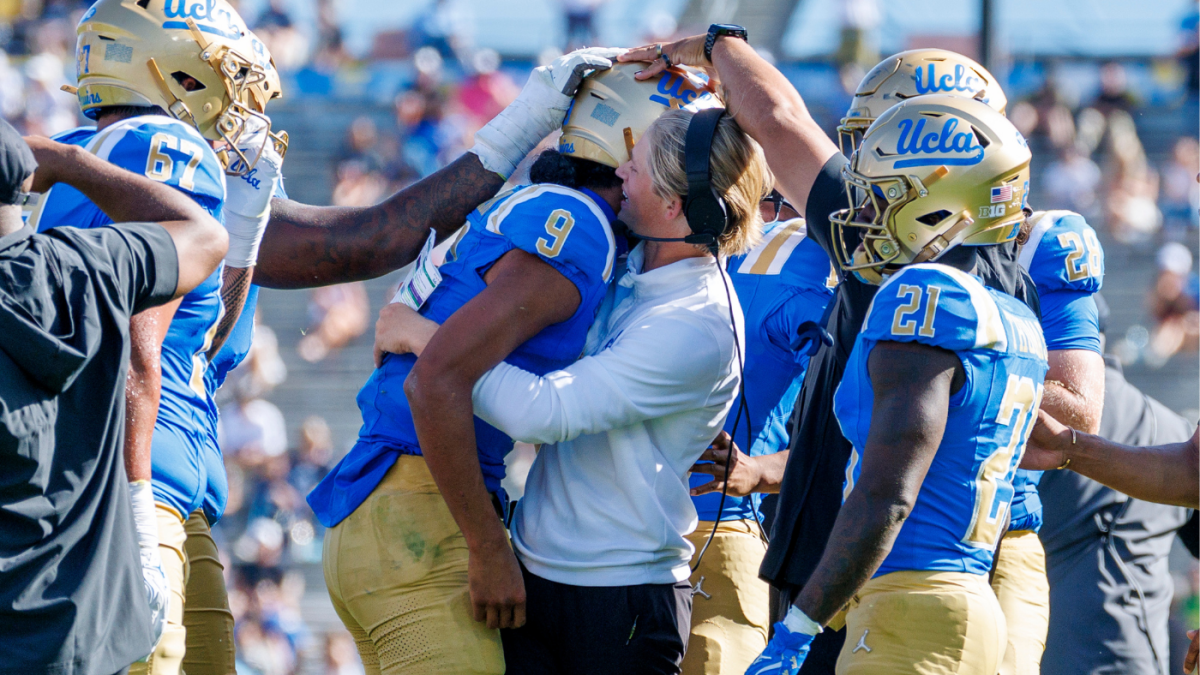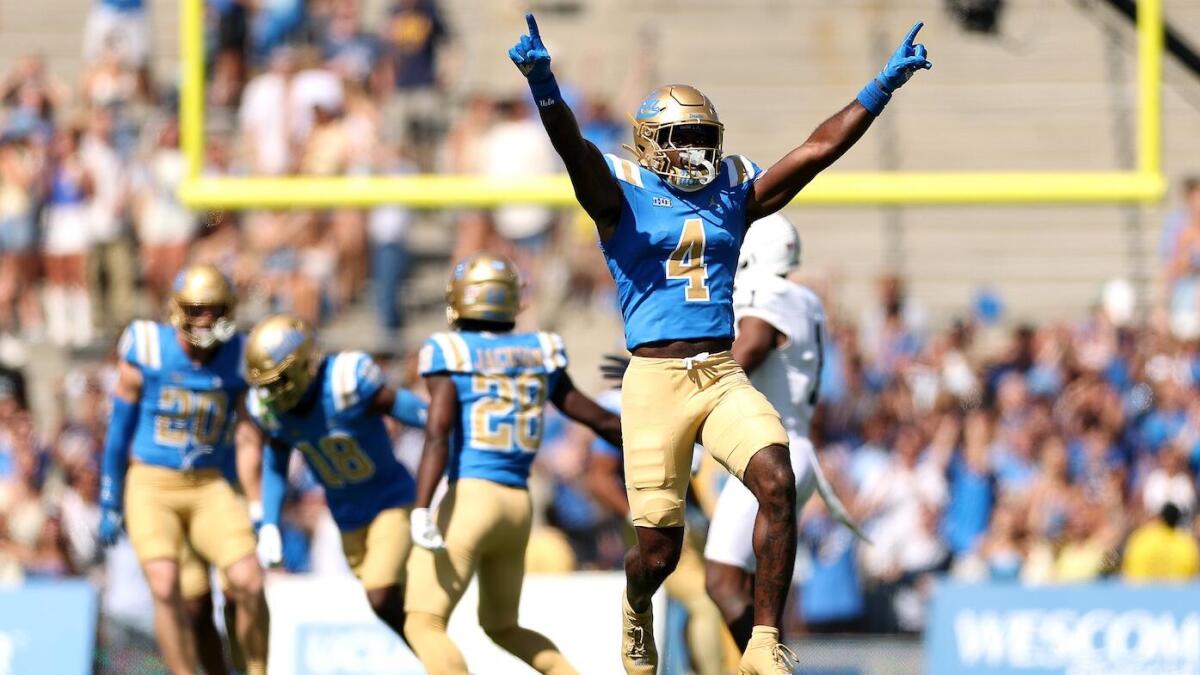UCLA was terrible; UCLA was pathetic; UCLA wouldn’t win a game all season. That was the opinion of many observers, including this column, which last Saturday questioned whether the Bruins were destined to lose forever.
No. 7 Penn State held every card entering their trip to UCLA Saturday—presumably they’d be motivated to absolutely woodshed a coach-less Bruins team that hadn’t led a game all season. Instead, the Nittany Lions looked hungover from their double-overtime loss to Oregon, and bowed to the Bruins 42–37.
The age of NIL rights and revenue sharing has obviously not eliminated the mismatch from college football, even within conferences. However, it has underlined what was probably always true: with almost every player on almost every team taking a quasi-salary, you’d better not take any week off.
Here’s hoping your team eagerly rolled out of bed and attended to its business this first weekend of October. Welcome to Week 6’s winners and losers.
The blueprint for UCLA’s upset began and ended with quarterback Nico Iamaleava. Look at that statistical line—17-for-24 for 166 yards and two touchdowns through the air; 128 yards on 16 carries for three touchdowns on the ground (his rushing yardage total nearly doubled his previous career high). It wasn’t just the frequently maligned Tennessee transfer, however: new offensive coordinator Jerry Neuheisel crafted a game plan that seized on every Nittany Lions mistake. The Bruins saluted Neuheisel with the rarely seen supreme gesture of American football respect: a trip off the field in the arms of his players.
To steal from Fight Club, we meet Penn State coach James Franklin at a very strange time in his life. Franklin is one win away from becoming the Nittany Lions’ winningest coach not named Joe Paterno, and he has contributed to repairing the program’s public image in the aftermath of one of North American sports’ most notorious scandals. On the field, however, fan discontent was already raging before Saturday—see the “Fire Franklin” chants that emanated from the Penn State student section against the Ducks. Against UCLA, the Nittany Lions’ ballyhooed defense deserted them—its 269 rushing yards allowed were a season high—and the beat-up squad lacked urgency at several key moments. No. 1 Ohio State—Franklin’s most durable Achilles heel—and No. 8 Indiana loom in the weeks to come.
In the most inspired effort by a Cincinnati-adjacent artistic project this week, the Bearcats opened a 17–0 lead on No. 14 Iowa State and handled every punch the Cyclones threw their way en route to an intriguing home win. Heroes: quarterback Brendan Sorsby (13-for-25 for 214 yards and two touchdowns), ex-Buckeyes running back Evan Pryor (111 yards on just 10 carries for two touchdowns), and linebacker Jake Golday (12 tackles for the third time this season). Coach Scott Satterfield’s future looked shaky after losing to Nebraska in his season opener, but now Cincinnati is 4-1 with one ranked team (No. 23 BYU) left on the schedule. With the Reds eliminated and Bengals struggling, the Bearcats won’t fly under the radar at home much longer.
Finally, after a trying September, North Carolina opened conference play against Clemson Saturday. The Tigers, however, wouldn’t let coach Bill Belichick’s squad get comfortable in any way, shape or form coming off a much-needed bye week. Tar Heels quarterback Max Johnson’s return from a nasty 2024 leg injury was the only element of Clemson’s 38–10 win worth writing home about from the Research Triangle. Tigers quarterback Cade Klubnik—22-for-24 for 254 yards and four scores—was almost flawless against a putrid defense that now must cross the country to play California on Oct. 17.
From Clay High School in the lovely bayside town of Oregon, Ohio—go Eagles!—came an unusually assured midseason quarterback debutant in the ACC. Replacing quarterback Eli Holstein—once a trendy far-future NFL prospect—18-year-old Mason Heintschel completely vexed Boston College in Pitt’s 48–7 win. Surprisingly considering the Panthers’ solid track record in recent years, the win was Pitt’s largest in conference play since 2016. Heintschel completed 30 of 41 passes for 323 yards and four touchdowns—can he keep it up during a two-week road swing against Florida State and Syracuse?
Florida’s defense could easily have made this week’s winners—the Gators have been nasty on that side of the ball this season; it kept them solvent against an obviously superior Miami team on Sept. 20. Make no mistake, however: Saturday was Texas’s loss to wear as quarterback Arch Manning struggled again in a 29–21 loss. With wildly varying numbers against Ohio State (a touchdown and a pick), UTEP (11-for-25), Sam Houston (18-for-21 for 309 yards), and Florida, (two touchdowns and two picks), it’s clear Manning as currently constituted is a decent quarterback—nothing more. Of more immediate concern to Longhorns fans is the fact that Texas could reach a win-out-or-face-the-Citrus-Bowl situation as soon as next Saturday, when it meets No. 5 Oklahoma.
If you’re in the habit of scrolling through box scores and arguing with people who watched whole games, you probably noticed something amiss during Navy’s 34–31 win over Air Force Saturday (and not just the fact that the Midshipmen are now 5-0). Eli Heidenreich, a running back from Pittsburgh, made history during the game by catching eight passes for 243 yards and three touchdowns. The yardage total was a single-game school record for a program long averse to the forward pass; his new career total of 14 is also a school record. Most forward-looking analyses of Navy go right to Notre Dame, but the Midshipmen should watch out for Temple next Saturday—3-2 in year one under FCS icon K.C. Keeler.
A shootout seemed preordained when No. 16 Vanderbilt visited No. 10 Alabama Saturday, but unlike last year’s contest, this game was played entirely on the Crimson Tide’s terms. Alabama hounded Commdores quarterback Diego Pavia all game, forcing the 24-year-old into two interceptions in a 30–14 loss that was closer than the score indicated. All the same, the contest ground one of the unlikelier Heisman campaigns in recent memory to at least a temporary halt (and potentially boosted Crimson Tide quarterback Ty Simpson’s hopes). Nashville, if nothing else, will always have the most awkward College GameDay moment of the millennium.
What’s going on in Conference USA? The once-proud league has become the disjointed black sheep of FBS in a sense—even the perennially downtrodden MAC’s schools have history together—but has produced some teams to watch this year. On Friday, the league enjoyed a telegenic moment: Western Kentucky defeated Delaware 27–24 before a national CBS Sports Network audience in a game that served as a sort of win for both schools. The Hilltoppers moved to 5-1 on the year—their only loss is to Toledo; they’ll visit No. 13 LSU in November. The Blue Hens, on the other hand, drew 19,179 fans—their largest home crowd in seven years and a nice morale boost for a team on its maiden FBS voyage. Delaware and Missouri State, Conference USA’s two ex-FCS newcomers, are a combined 5-5 in 2025.
No team in the country blew a bigger opportunity than Maryland Saturday. On College GameDay, the Terrapins served as a trivia answer—which three teams entered Saturday not having trailed this season? Where Miami and Texas Tech thrived, Maryland took a nosedive—going up 20–0 and frittering its lead away to a determined Washington. The Huskies, who wound up outgaining the Terrapins by 100 yards, were deserving winners—but Maryland has to be kicking itself after managing just 52 yards on its final four drives. The September Terrapins persevere another year.
More College Football on Sports Illustrated
Source link


